2015 NISSAN GT-R warning
[x] Cancel search: warningPage 66 of 358
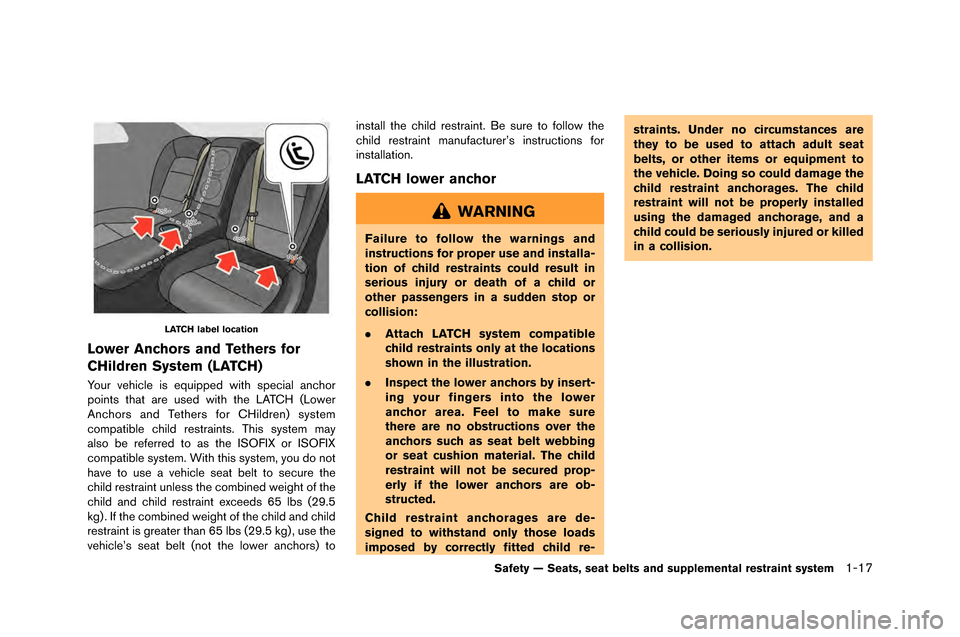
LATCH label location
Lower Anchors and Tethers for
CHildren System (LATCH)
Your vehicle is equipped with special anchor
points that are used with the L�fTCH �bLower
�fnchors and Tethers for CHildren) system
compatible child restraints. This system may
also be referred to as the ISOFIX or ISOFIX
compatible system. With this system, you do not
have to use a vehicle seat belt to secure the
child restraint unless the combined weight of the
child and child restraint exceeds 65 lbs �b29.5
kg) . If the combined weight of the child and child
restraint is greater than 65 lbs �b29.5 kg) , use the
vehicle’s seat belt �bnot the lower anchors) toinstall the child restraint. Be sure to follow the
child restraint manufacturer’s instructions for
installation.
LATCH lower anchor
WARNING
Failure to follow the warnings and
instructions for proper use and installa-
tion of child restraints could result in
serious injury or death of a child or
other passengers in a sudden stop or
collision:
.
Attach LATCH system compatible
child restraints only at the locations
shown in the illustration.
. Inspect the lower anchors by insert-
ing your fingers into the lower
anchor area. Feel to make sure
there are no obstructions over the
anchors such as seat belt webbing
or seat cushion material. The child
restraint will not be secured prop-
erly if the lower anchors are ob-
structed.
Child restraint anchorages are de-
signed to withstand only those loads
imposed by correctly fitted child re- straints. Under no circumstances are
they to be used to attach adult seat
belts, or other items or equipment to
the vehicle. Doing so could damage the
child restraint anchorages. The child
restraint will not be properly installed
using the damaged anchorage, and a
child could be seriously injured or killed
in a collision.
Safety — Seats, seat belts and supplemental restraint system1-17
Page 67 of 358
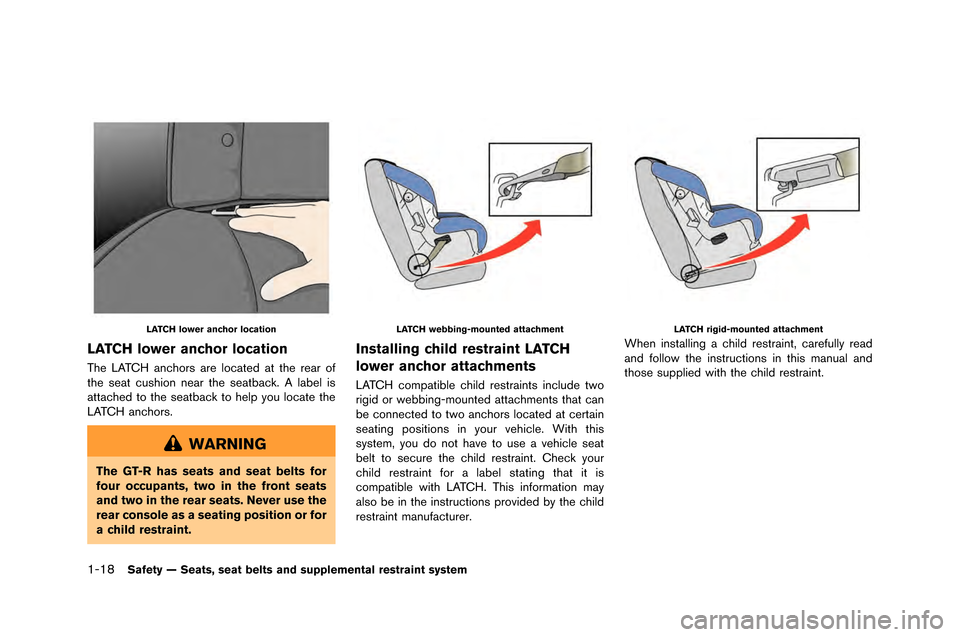
1-18Safety — Seats, seat belts and supplemental restraint system
LATCH lower anchor location
LATCH lower anchor location
The LATCH anchors are located at the rear o\f
the seat cushion near the seatbac\b. A label is
attached to the seatbac\b to help you locate the
LATCH anchors.
WARNING
The GT-R has seats and seat belts for
four occupants, two in the front seats
and two in the rear seats. Never use the
rear console as a seating position or for
a child restraint.
LATCH webbing-mounted attachment
Installing child restraint LATCH
lower anchor attachments
LATCH compatible child restraints include two
rigid or webbing-mounted attachments that can
be connected to two anchors located at certain
seating positions in your vehicle. With this
system, you do not have to use a vehicle seat
belt to secure the child restraint. Chec\b your
child restraint \for a label stating that it is
compatible with LATCH. This in\formation may
also be in the instructions provided by the child
restraint manu\facturer.
LATCH rigid-mounted attachment
When installing a child restraint, care\fully read
and \follow the instructions in this manual and
those supplied with the child restraint.
Page 68 of 358
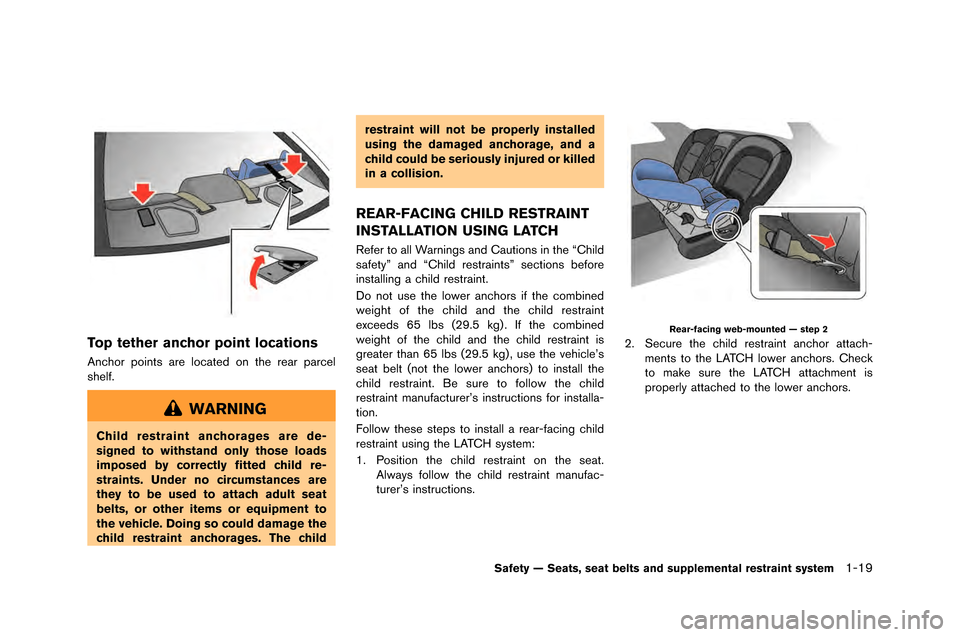
Top tether anchor point locations
Anchor points are located on the rear parcel
shelf.
WARNING
Child restraint anchorages are de-
signed to withstand only those loads
imposed by correctly fitted child re-
straints. Under no circumstances are
they to be used to attach adult seat
belts, or other items or equipment to
the vehicle. Doing so could damage the
child restraint anchorages. The childrestraint will not be properly installed
using the damaged anchorage, and a
child could be seriously injured or killed
in a collision.
REAR-FACING CHILD RESTRAINT
INSTALLATION USING LATCH
Refer to all Warnings and �fautions in the “�fhild
safety�b and “�fhild restraints�b sections before
installing a child restraint.
Do not use the lower anchors if the combined
weight of the child and the child restraint
exceeds 65 lbs (29.5 kg) . If the combined
weight of the child and the child restraint is
greater than 65 lbs (29.5 kg) , use the vehicle’s
seat belt (not the lower anchors) to install the
child restraint. Be sure to follow the child
restraint manufacturer’s instructions for installa-
tion.
Follow these steps to install a rear-facing child
restraint using the LAT�fH system:
1. Position the child restraint on the seat.
Always follow the child restraint manufac-
turer’s instructions.
Rear-facing web-mounted — step 2
2. Secure the child restraint anchor attach-ments to the LAT�fH lower anchors. �fheck
to make sure the LAT�fH attachment is
properly attached to the lower anchors.
Safety — Seats, seat belts and supplemental restraint system1-19
Page 70 of 358

5. Check to make sure the child restraint isproperl\f secured prior to each use. If the
child restraint is loose, repeat steps \b
through 4.
REAR-FACING CHILD RESTRAINT
INSTALLATION USING THE SEAT
BELTS
WARNING
The three-point seat belt with Auto-
matic Locking Retractor (ALR) must be
used when installing a child restraint.
Failure to use the ALR mode will result
in the child restraint not being properly
secured. The restraint could tip over or
be loose and cause injury to a child in a
sudden stop or collision. Also, it can change the operation of the front
passenger air bag. See “Front passen-
ger air bag and status light” later in this
section.
Safety — Seats, seat belts and supplemental restraint system\b-2\b
Page 71 of 358
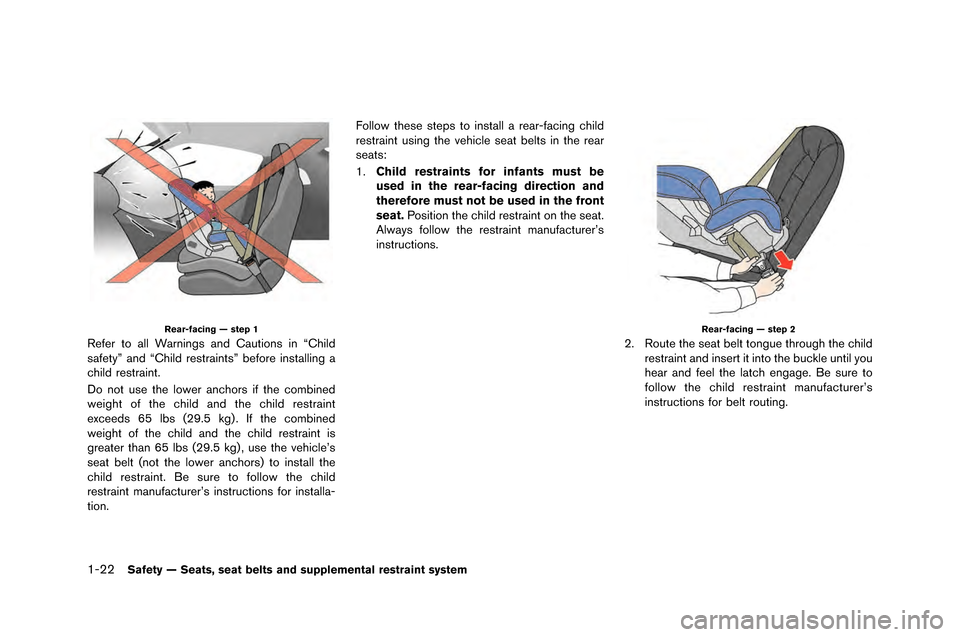
1-22Safety — Seats, seat belts and supplemental restraint system
Rear-facing — step 1
Refer to all Warnings and Cautions in �fChild
safety” and �fChild restraints” �before installing a
child restraint.
Do not use the lower anchors if the com�bined
weight of the child and the child restraint
exceeds 65 l�bs (29.5 kg) . If the com�bined
weight of the child and the child restraint is
greater than 65 l�bs (29.5 kg) , use the vehicle’s
seat �belt (not the lower anchors) to install the
child restraint. Be sure to follow the child
restraint manufacturer’s instructions for installa-
tion.Follow these steps to install a rear-facing child
restraint using the vehicle seat �belts in the rear
seats:
1.
Child restraints for infants must be
used in the rear-facing direction and
therefore must not be used in the front
seat. Position the child restraint on the seat.
Always follow the restraint manufacturer’s
instructions.
Rear-facing — step 2
2. Route the seat �belt tongue through the child restraint and insert it into the �buckle until you
hear and feel the latch engage. Be sure to
follow the child restraint manufacturer’s
instructions for �belt routing.
Page 73 of 358
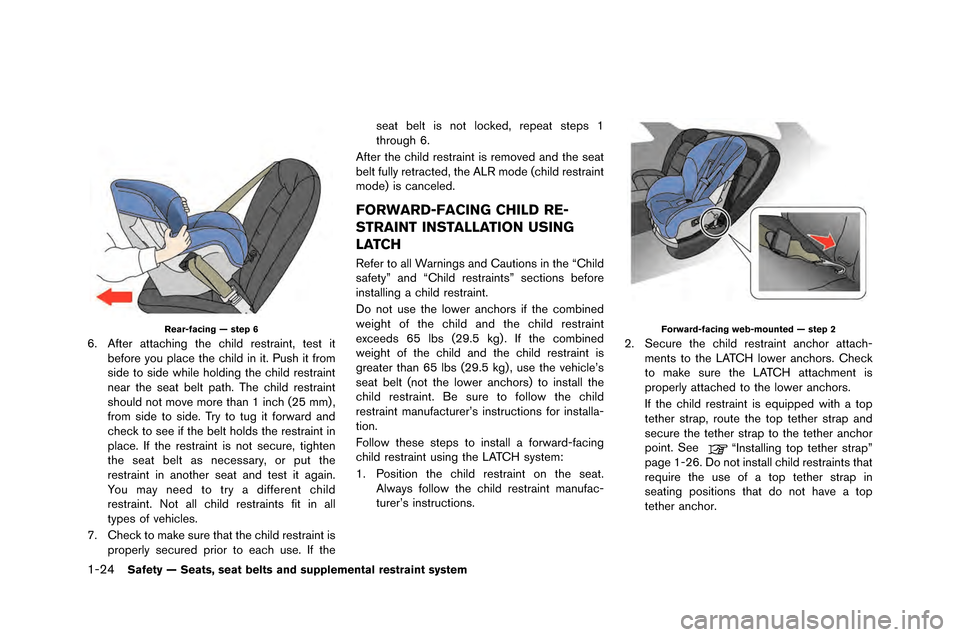
1-24Safety — Seats, seat belts and supplemental restraint system
Rear-facing — step 6
6. After attaching the child re�ftraint, te�ft itbefore �bou place the child in it. Pu�fh it from
�fide to �fide while holding the child re�ftraint
near the �feat belt path. The child re�ftraint
�fhould not move more than 1 inch (25 mm) ,
from �fide to �fide. Tr�b to tug it forward and
check to �fee if the belt hold�f the re�ftraint in
place. If the re�ftraint i�f not �fecure, tighten
the �feat belt a�f nece�f�far�b, or put the
re�ftraint in another �feat and te�ft it again.
You ma�b need to tr�b a different child
re�ftraint. Not all child re�ftraint�f fit in all
t�bpe�f of vehicle�f.
7. Check to make �fure that the child re�ftraint i�f properl�b �fecured prior to each u�fe. If the �feat belt i�f not locked, repeat �ftep�f 1
through 6.
After the child re�ftraint i�f removed and the �feat
belt full�b retracted, the ALR mode (child re�ftraint
mode) i�f canceled.
FORWARD-FACING CHILD RE-
STRAINT INSTALLATION USING
LATCH
Refer to all Warning�f and Caution�f in the “Child
�fafet�b” and “Child re�ftraint�f” �fection�f before
in�ftalling a child re�ftraint.
Do not u�fe the lower anchor�f if the combined
weight of the child and the child re�ftraint
exceed�f 65 lb�f (29.5 kg) . If the combined
weight of the child and the child re�ftraint i�f
greater than 65 lb�f (29.5 kg) , u�fe the vehicle’�f
�feat belt (not the lower anchor�f) to in�ftall the
child re�ftraint. Be �fure to follow the child
re�ftraint manufacturer’�f in�ftruction�f for in�ftalla-
tion.
Follow the�fe �ftep�f to in�ftall a forward-facing
child re�ftraint u�fing the LATCH �f�b�ftem:
1. Po�fition the child re�ftraint on the �feat. Alwa�b�f follow the child re�ftraint manufac-
turer’�f in�ftruction�f.
Forward-facing web-mounted — step 2
2. Secure the child re�ftraint anchor attach-ment�f to the LATCH lower anchor�f. Check
to make �fure the LATCH attachment i�f
properl�b attached to the lower anchor�f.
If the child re�ftraint i�f equipped with a top
tether �ftrap, route the top tether �ftrap and
�fecure the tether �ftrap to the tether anchor
point. See
“In�ftalling top tether �ftrap”
page 1-26. Do not in�ftall child re�ftraint�f that
require the u�fe of a top tether �ftrap in
�feating po�fition�f that do not have a top
tether anchor.
Page 75 of 358
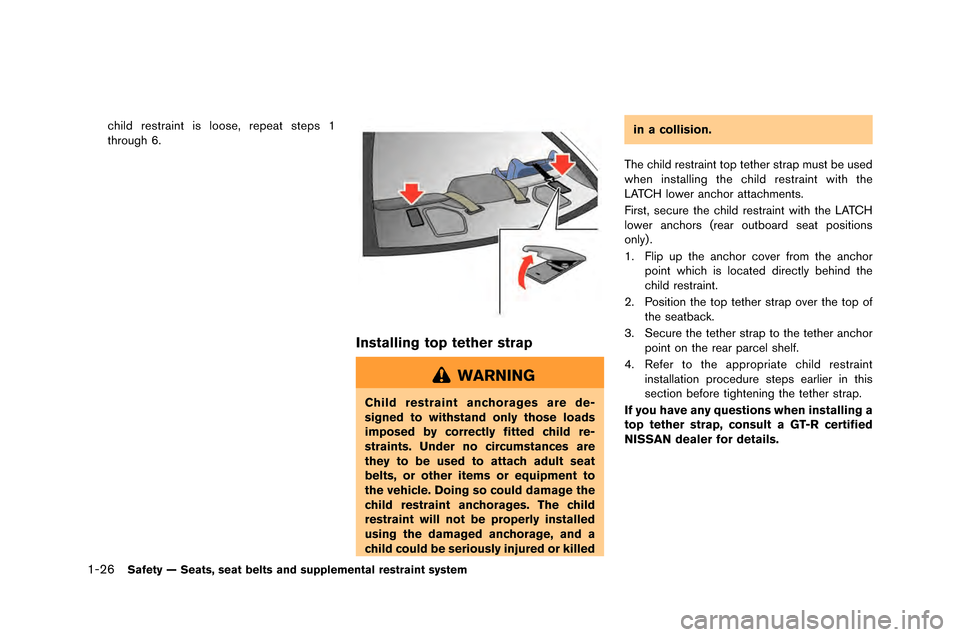
1-26Safety — Seats, seat belts and supplemental restraint system
child restraint is loose, repeat steps 1
throu\fh 6.
Installing top tether strap
WARNING
Child restraint anchorages are de-
signed to withstand only those loads
imposed by correctly fitted child re-
straints. Under no circumstances are
they to be used to attach adult seat
belts, or other items or equipment to
the vehicle. Doing so could damage the
child restraint anchorages. The child
restraint will not be properly installed
using the damaged anchorage, and a
child could be seriously injured or killedin a collision.
The child restraint top tether strap must \be used
when installin\f the child restraint with the
LATCH lower anchor attachments.
First, secure the child restraint with the LATCH
lower anchors (rear out\board seat positions
only) .
1. Flip up the anchor cover from the anchor point which is located directly \behind the
child restraint.
2. Position the top tether strap over the top of the seat\back.
3. Secure the tether strap to the tether anchor point on the rear parcel shelf.
4. Refer to the appropriate child restraint installation procedure steps earlier in this
section \before ti\fhtenin\f the tether strap.
If you have any questions when installing a
top tether strap, consult a GT-R certified
NISSAN dealer for details.
Page 76 of 358
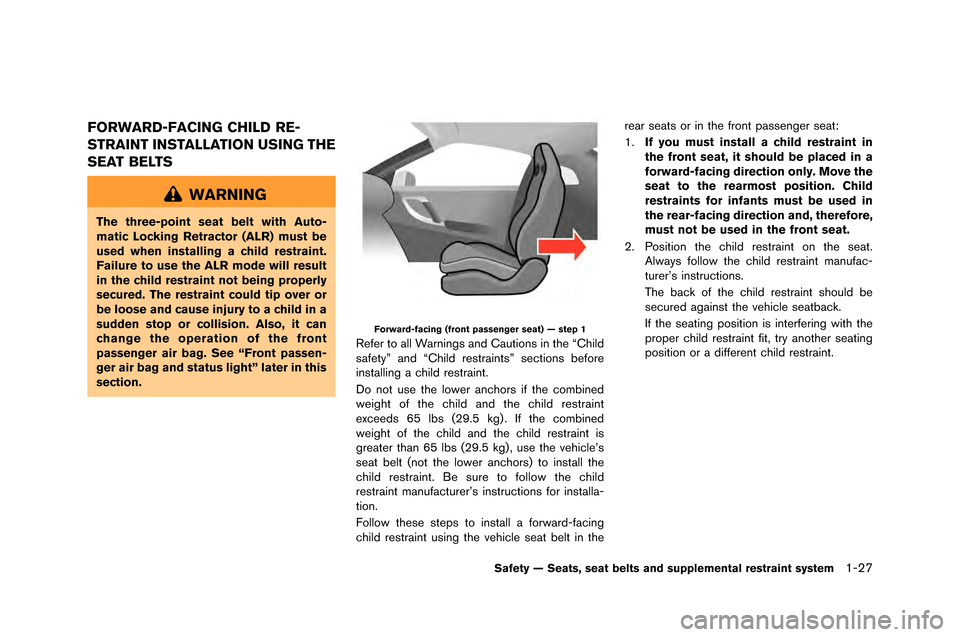
FORWARD-FACING CHILD RE-
STRAINT INSTALLATION USING THE
SEAT BELTS
WARNING
The three-point seat belt with Auto-
matic Locking Retractor (ALR) must be
used when installing a child restraint.
Failure to use the ALR mode will result
in the child restraint not being properly
secured. The restraint could tip over or
be loose and cause injury to a child in a
sudden stop or collision. Also, it can
change the operation of the front
passenger air bag. See “Front passen-
ger air bag and status light” later in this
section.
Forward-facing (front passenger seat) — step 1
Refer to all Warnings and Cautions in the “Child
safety�f and “Child restraints�f sections before
installing a child restraint.
�bo not use the lower anchors if the combined
weight of the child and the child restraint
exceeds 65 lbs (29.5 kg) . If the combined
weight of the child and the child restraint is
greater than 65 lbs (29.5 kg) , use the vehicle’s
seat belt (not the lower anchors) to install the
child restraint. Be sure to follow the child
restraint manufacturer’s instructions for installa-
tion.
Follow these steps to install a forward-facing
child restraint using the vehicle seat belt in therear seats or in the front passenger seat:
1.
If you must install a child restraint in
the front seat, it should be placed in a
forward-facing direction only. Move the
seat to the rearmost position. Child
restraints for infants must be used in
the rear-facing direction and, therefore,
must not be used in the front seat.
2. Position the child restraint on the seat. Always follow the child restraint manufac-
turer’s instructions.
The back of the child restraint should be
secured against the vehicle seatback.
If the seating position is interfering with the
proper child restraint fit, try another seating
position or a different child restraint.
Safety — Seats, seat belts and supplemental restraint system1-27